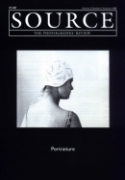EDITORIAL:
Issue 9 — Autumn 1996
Issue 9 — Autumn 1996
View Contents ▸
Andre Felibien in the 17th Century first suggested the use of the term 'portrait' exclusively for likenesses of (certain) human beings. Up until then 'portrait' and 'likeness' could be used to mean pictorial imitation of any kind; animal, vegetable or mineral included. In the pioneering days of photography in the 19th Century the lead in technical development was given by the need to reduce exposure times for making portraits. The 15 or more minutes required in bright sunlight was reduced to less than 60 seconds. In 1842 Francis S. Beatty opened Ireland's first daguerreotype portrait gallery in Belfast.
Paul Quinn, Anne Bjerge Hansen and Christopher Taylor produce faithful renderings of their sitters in our extended 'portfolio' pages. Quinn and Bjerge Hansen both recent graduates exemplify the excellence of images produced on 'specialist' Photographic degree courses. Source met Christopher Taylor in Arles at France's major photographic festival. We review the event and look forward to increasing the International content of the magazine through the contacts we made there.
Tony Blair's 'devil's eyes' on the recent Conservative Party poster revealed the potency of photographic montage. We review the new book from photomontage artist Peter Kennard, perhaps best known for his images dealing with nuclear disarmament and interview Irish photomontage artist Sean Hillen. Both fly the flag for low tech image manipulation. Scissors and glue meet the digital imaginings of the Bonk Business Inc.
— John Duncan





